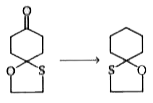In-situ conservation of natural genetic resources can be achieved by establishing
National Parks
Wildlife sanctuaries
Biosphere reserves
All of these
The correct Answer is:D
Step-by-Step Solution:
1. Understanding In-situ Conservation: In-situ conservation refers to the conservation of species in their natural habitats. This method helps maintain the ecological processes and genetic diversity of species.
2. Identifying Conservation Areas: The question asks about the establishment of areas for in-situ conservation. The options provided are:
- National Parks
- Wildlife Sanctuaries
- Biosphere Reserves
3. Defining Each Area:
- National Parks: These are protected areas established to conserve wildlife and their habitats. They provide a safe environment for various species and help in preserving biodiversity.
- Wildlife Sanctuaries: These are areas designated to protect animals and their habitats. They offer a safe haven for species that may be threatened or endangered.
- Biosphere Reserves: These are multipurpose protected areas that aim to conserve biodiversity, promote research, and support sustainable development. They encompass various ecosystems and provide a habitat for numerous species.
4. Conclusion: All three options (National Parks, Wildlife Sanctuaries, and Biosphere Reserves) are effective strategies for in-situ conservation of natural genetic resources. Therefore, the correct answer is "all of these."
Final Answer: In-situ conservation of natural genetic resources can be achieved by establishing all of these: National Parks, Wildlife Sanctuaries, and Biosphere Reserves.
---
- National Parks
- Wildlife Sanctuaries
- Biosphere Reserves
- National Parks: These are protected areas established to conserve wildlife and their habitats. They provide a safe environment for various species and help in preserving biodiversity.
- Wildlife Sanctuaries: These are areas designated to protect animals and their habitats. They offer a safe haven for species that may be threatened or endangered.
- Biosphere Reserves: These are multipurpose protected areas that aim to conserve biodiversity, promote research, and support sustainable development. They encompass various ecosystems and provide a habitat for numerous species.
Topper's Solved these Questions
- BIODIVERSITY AND CONSERVATION BOOK - CENGAGE BIOLOGY ENGLISHCHAPTER - BIODIVERSITY AND CONSERVATION EXERCISE - Assertion-Reasoning Questions
5 Videos
- BIODIVERSITY AND CONSERVATION BOOK - CENGAGE BIOLOGY ENGLISHCHAPTER - BIODIVERSITY AND CONSERVATION EXERCISE - Archives
22 Videos
- BIOTECHNOLOGY AND ITS APPLICATIONSBOOK - CENGAGE BIOLOGY ENGLISHCHAPTER - BIOTECHNOLOGY AND ITS APPLICATIONSEXERCISE - ARCHIVES (CHOOSE THE CORRECT OPTIONS)
21 Videos
Similar Questions
Knowledge Check
 this conversion can be achieved by AO3,Zn, then LiAlH4BO3/H2O2, then LiAlH4Ccold dil . KMnO4HlO4, then LiAlH4DAll of these
this conversion can be achieved by AO3,Zn, then LiAlH4BO3/H2O2, then LiAlH4Ccold dil . KMnO4HlO4, then LiAlH4DAll of these
Above conversion can be achieved byAWolf Kisher reductionBClemmensen reductionCLiAlH4DNaBH4
Above conversion can be achieved by :AWolf-Kishner reductionBClemmensen reductionCLiAlH4DNaBH4





 , This conversion can be achieved by :
, This conversion can be achieved by :